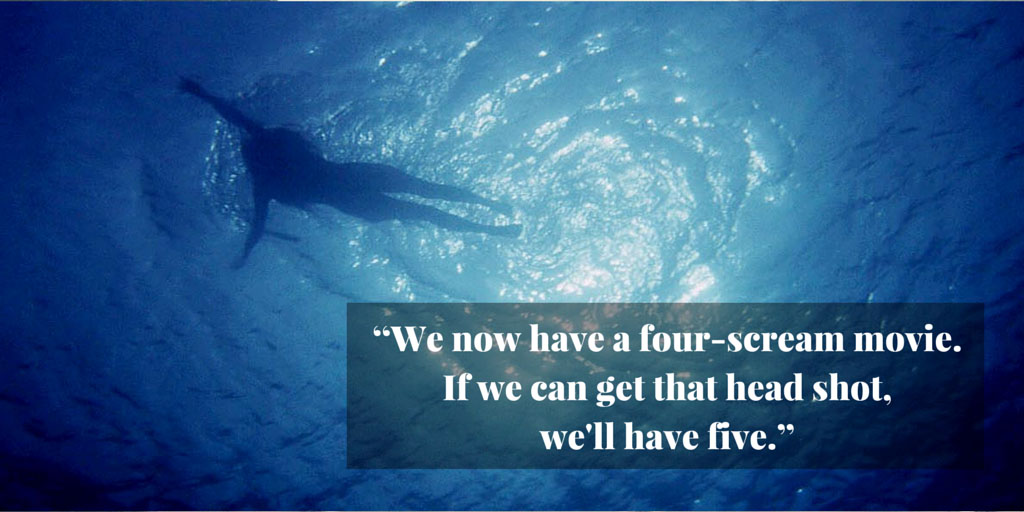Nine Things You Probably Didn’t Know About Jaws, as Told By Its Cast and Crew

Film still from Jaws
If you haven’t had your fill of shark sightings this summer, we’ve got just the thing for you. With Jaws turning 40 this year, theaters all over Massachusetts have been hosting special anniversary screenings of the legendary shark film, including this weekend’s Jaws extravaganza at the Somerville Theatre.
Looking back on the history of the film, it’s remarkable that 27-year-old Steven Spielberg, then a relative unknown, was able to navigate treacherous Cape Cod weather and wrangle that ornery mechanical shark—which was actually three mechanical sharks called Bruce, named after Spielberg’s lawyer—to successfully unleash the world’s first summer blockbuster on an unsuspecting world. Even Boston magazine was a bit dazzled, calling the film “a nerve-cruncher and a smash” in our original 1975 review.
But you’ll find that the deeper you dive into Jaws lore, the more amazing the story becomes.
Back in 2005, to commemorate the 30th anniversary of Spielberg’s film, Boston magazine’s Andrew Rimas rounded up the people who were responsible for transforming that nearly doomed movie into the hit we know it as today. Their collective oral history of “that manic, chummy summer” became a piece that Boston magazine published as “A Shark’s Tale”—and revealed some truly mind-boggling Jaws facts. Enjoy.
1. The film’s most immortal line was never in the script.
“Occasionally someone will compliment me on the line, “You’re gonna need a bigger boat.” But Roy [Scheider] ad-libbed that on set.”
—Carl Gottlieb (co-screenwriter, actor, and Spielberg’s housemate)
2. The shark started out as a coat hanger.
“They looked at it as a low-budget horror film. So we decided to make the shark independently. I found Bob Mattey, who was responsible for the squid in 20,000 Leagues Under the Sea, and he came up with a coat-hanger-wire model of a shark, a skeleton with levers that moved it side to side and up and down. We had a $4 million budget.”
—Joe Alves (production designer)
3. Not only were many of the actors real Cape Codders, they were also real selectmen.
“We cast 10 speaking parts from the Boston SAG office to keep the unions happy, but the majority of the casting was done on the island. It was a little while before we could understand what each other was saying. I had this real Texas accent, even more than I do now. And that New England sound! The selectmen in the movie were mostly real selectmen, interspersed with actors, but you can hardly tell the difference.”
—Shari Rhodes (casting director)
4. Captain Quint was based on a real person …
“[Robert] Shaw always denied it, but his character and dialogue were based on [a local fisherman and selectman named] Craig Kingsbury. I gave him a tape recorder to read all of Shaw’s lines into, and he did it and gave it to Steven, who gave it to Shaw.”
—S.R.
5. … Who was also “the only person in history to get arrested for drunken driving in an ox cart.”
“[Kingsbury] passed out asleep, and the ox just stood there blocking traffic.”
—S.R.
6. Murray Hamilton, the actor who played the mayor, got sprayed by a skunk—which Kingsbury took credit for.
“He was walking back to his hotel from dinner and he reached down to pet a cute black-and-white kitty! When he went to the lobby of the hotel the people said, ‘Get outta here!’ He smelled so bad I think they wouldn’t let him in his room. He had to sleep on the porch or something. … Craig Kingsbury told me, ‘He wouldn’t have gotten sprayed if I hadn’t brought skunks over to the island. They didn’t have any on the island, and I thought it wasn’t ecologically balanced. So I brought them over.’ [Laughs.] He was wonderful.”
—S.R.
7. Robert Shaw and Richard Dreyfuss settled a grudge with a food fight.
“On those interminable days at sea, Shaw used to drink and smoke. Once, he was sipping a drink or having a cigarette, and he mentioned offhand, ‘I’d like to be able to quit these things.’ Richard reached across the table, took the cigarette or drink, and threw it out the porthole. Everybody blanched. Normally you’d get a punch for your trouble. It was a shocker. I think Robert wanted to break a chair over Richard’s head, but he restrained himself. They had a food fight later, and that was the end of it.”
—C.G.
8. They didn’t just need a bigger boat: Hooper’s shark-cage scene also required a smaller stuntman.
“We knew we could never shoot the entire length of that with a mechanical shark, so I went to Australia to get shots of a real shark circling the cage. The problem was, the shark in the movie was 25 feet long and the biggest shark ever caught was only 16 feet long. The obvious way to deal with the scale problem was to reduce the size of the cage. If you reduce the size of the cage by a third, you have to reduce the size of the actor by a third, so I started to look for a midget stuntman. Seriously. I had to find somebody who had the skills, who was a midget, who had his own scuba equipment. I sent a crew and the midget stuntman down there, and we got word that they had radioed in and had a 16-foot great white shark, and they were going to start shooting. About 24 hours later I got a call, and they told me that they had just shot the most exciting shark footage that they had ever seen. The great white shark got into the line from the cage to the support boat. He got it caught in his gills and he went bananas. Thrashing. He just went crazy. The shark reared out of the water and almost landed in the support boat. I said, ‘Was the little guy in the cage?’ He hadn’t gone in yet. My heart sank. But the footage was spectacular. Exactly the footage we needed.”
—Bill Gilmore (production executive)
9. That scene with the lifeless head of Ben Gardner (a role played by Kingsbury) was filmed in a swimming pool.
“After we left, we still picked up a few shots, like Ben Gardner, the fisherman whose head comes out of the boat. Steven said, ‘We now have a four-scream movie. If we can get that head shot, we’ll have five.’ So we stole the prosthetic head out of the makeup department, and we shot it in [editor] Verna Fields’s swimming pool.”
—J.A.


